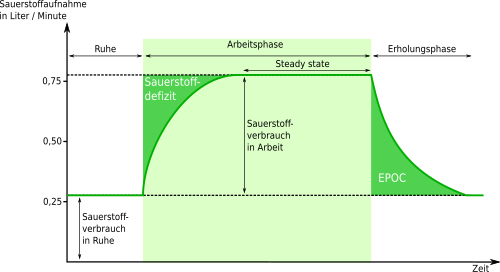Oxygen deficit
An oxygen deficit arises from the slower increase in oxygen consumption compared to the increase in performance during physical work . The oxygen demand is initially covered by resorting to the body's own oxygen reserves in the alveolar air as well as in hemoglobin and myoglobin ; the further generation of energy in the form of ATP takes place v. a. via lactic acid fermentation with lactate formation (see Anaerobia # Anaerobic respiration ) and the hydrolysis of creatine phosphate .
The extent of the oxygen deficit depends on the performance, the level of training and age . Sufficient oxygen uptake is achieved approximately two to six minutes after starting physical activity with submaximal exercise. If the work intensity remains constant, a steady state is established . The time until the state of the steady state of the O 2 uptake has occurred is referred to as the work start-up time.
After the end of the exercise, there is a delayed decrease in oxygen uptake, which is referred to as EPOC (excess postexercise oxygen consumption) .
See also
Individual evidence
- ^ Pschyrembel - Clinical Dictionary, 261st edition, 2007 Walter de Gruyter, Berlin
- ^ Wildor Hollmann and Theodor Hettinger: Sports medicine. 4th edition, Schattauer, Stuttgart 2000, ISBN 3-7945-1672-9 , p. 69
